Oracle Bundle
How Did Oracle Conquer the Tech World?
Oracle Corporation, a titan in the tech industry, boasts a compelling history of innovation and strategic prowess. From its inception in 1977, Oracle has fundamentally reshaped how businesses manage and utilize data. This journey, marked by groundbreaking database technology and relentless expansion, offers valuable lessons for investors and business strategists alike.
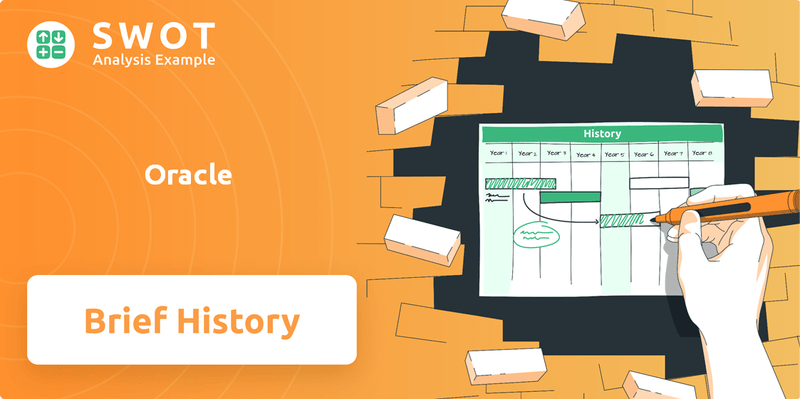
The Oracle SWOT Analysis illuminates the company's strengths and weaknesses, providing a crucial understanding of its market position. Founded by Larry Ellison, Bob Miner, and Ed Oates, Oracle's early days centered on commercializing a relational database model, a concept that would revolutionize the software company. Today, Oracle's evolution over time continues, with a strong focus on cloud computing and AI integration, making it a key player in the global technology landscape.
What is the Oracle Founding Story?
The Oracle company history began on June 16, 1977, in Santa Clara, California. It was founded by Larry Ellison, Bob Miner, and Ed Oates. Initially, they named their venture Software Development Laboratories (SDL).
The founders drew inspiration from Edgar F. Codd's work on relational database management systems (RDBMS). Ellison saw the commercial potential in Codd's relational model, which efficiently stored and retrieved large amounts of data. Their focus was on developing and marketing a program based on this theory.
The company's early journey involved significant shifts and strategic decisions that shaped its future in the tech industry. The early days of Oracle Corporation set the stage for its evolution.
Who founded Oracle is a question often asked. Larry Ellison, Bob Miner, and Ed Oates were the founders, and they started with a modest investment.
- The initial capital was $2,000, with Ellison contributing $1,400.
- The first product, Oracle's first database product, was released in 1979 as 'Oracle v2'.
- The company's first customer was the U.S. Air Force.
- The name 'Oracle' came from a project for the CIA.
In 1979, SDL changed its name to Relational Software, Inc. (RSI), and then to Oracle Systems Corporation in 1982. This name change aligned with its primary product, the Oracle Database. The company's growth was fueled by its innovation in database technology, which catered to the growing needs of businesses for managing large datasets. The company's early successes laid the groundwork for its expansion.
The company's evolution over time shows its adaptability and strategic vision.
- SDL became RSI in 1979.
- RSI became Oracle Systems Corporation in 1982.
- The company focused on its core product, the Oracle Database.
- These changes reflected the company's growing prominence.
The rise of Oracle database significantly impacted the tech industry. The company's early focus on relational databases set it apart. Oracle's impact on the tech industry is undeniable, as it became a key player in enterprise software. The company's Oracle's role in business expanded as it provided solutions for various industries.
The company's initial strategy was key to its early success. The founders, including Larry Ellison, made strategic decisions.
- Focus on relational database technology.
- Targeting the U.S. Air Force as a customer.
- Strategic name changes.
- Building a strong foundation for future growth.
Oracle's journey from a small startup to a global software company is a testament to its vision and adaptability. The company's early decisions, including its focus on relational databases and its strategic partnerships, were crucial. For more insights into the company's core values, read about the Mission, Vision & Core Values of Oracle.
Oracle SWOT Analysis
- Complete SWOT Breakdown
- Fully Customizable
- Editable in Excel & Word
- Professional Formatting
- Investor-Ready Format
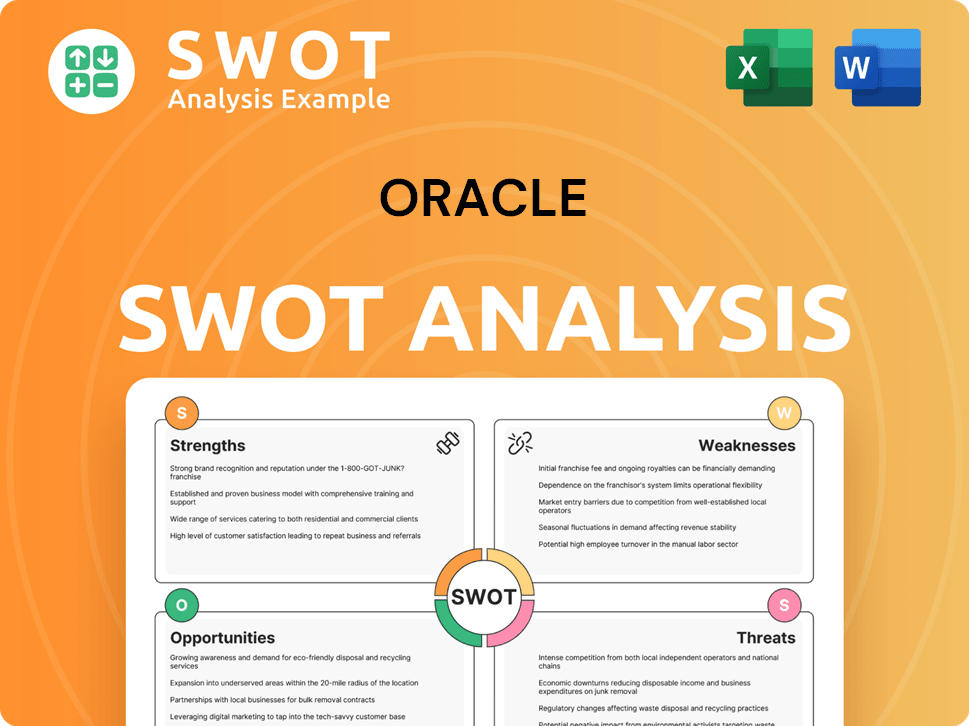
What Drove the Early Growth of Oracle?
The early growth of the Oracle Corporation, a pivotal period in the history of Oracle, was marked by rapid product development and strategic market penetration. Following the release of Oracle v2 in 1979, the company expanded its reach by porting its database software to various platforms. This period also saw the company's initial public offering and its rise to become the world's largest database management company by 1987.
After the release of Oracle v2, the software company focused on porting its database software to various platforms. The VAX platform was targeted in October 1979, and the PC platform, with an MS-DOS version, followed in November 1984. In March 1983, Oracle Database was rewritten in C for portability, leading to Oracle v3.
The company went public on March 12, 1986, raising $31.5 million. By 1987, Oracle had become the largest database management company globally. The history of Oracle includes its expansion through acquisitions, starting with the Rdb division of Digital Equipment Corporation in 1994.
Oracle faced intense competition from larger companies like IBM and Microsoft. Oracle positioned itself as a more affordable alternative, contributing to sales growth. Under Larry Ellison's leadership, the strategic vision was to dominate the enterprise software market through continuous innovation and integration.
Oracle built a loyal customer base through a focus on customer service and support. The company's early success helped shape the database technology landscape. To understand the competitive environment Oracle faced, you can explore the Competitors Landscape of Oracle.
Oracle PESTLE Analysis
- Covers All 6 PESTLE Categories
- No Research Needed – Save Hours of Work
- Built by Experts, Trusted by Consultants
- Instant Download, Ready to Use
- 100% Editable, Fully Customizable
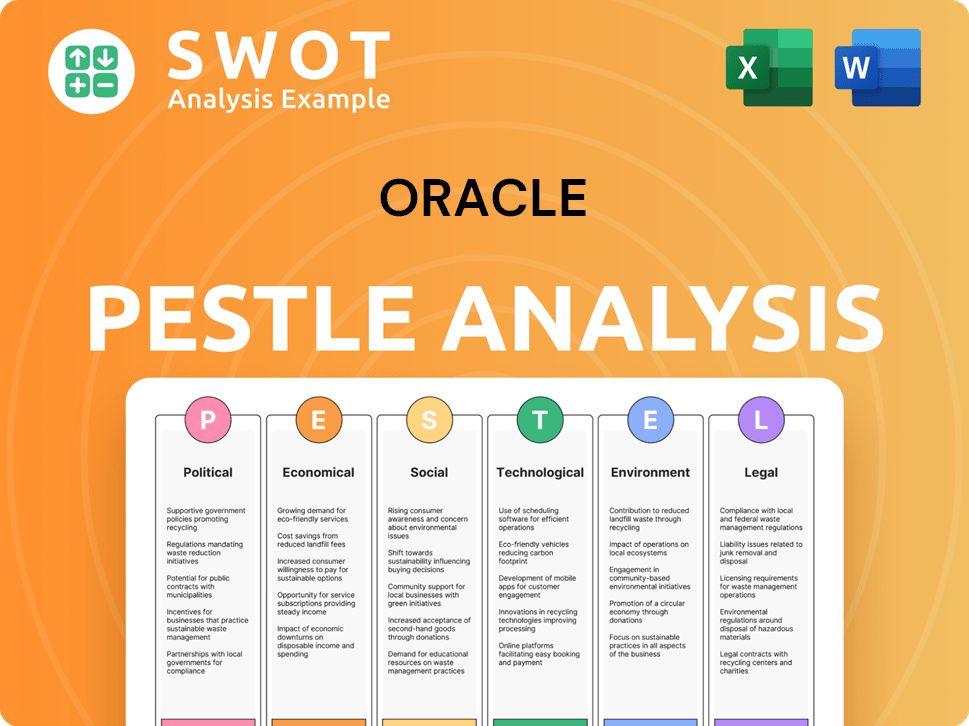
What are the key Milestones in Oracle history?
The Oracle company history is marked by significant milestones, from its early days to its current position as a major player in the technology industry. The company's journey reflects its evolution and impact on the tech landscape.
| Year | Milestone |
|---|---|
| 1977 | Oracle Corporation was founded by Larry Ellison, Bob Miner, and Ed Oates. |
| 1979 | Oracle released Oracle 2, the first commercial SQL relational database. |
| 1992 | Oracle Database 7 was launched, bringing significant improvements in scalability and performance. |
| 1998 | Oracle 8i was released, integrating internet capabilities directly into the database. |
| 2010 | Acquisition of Sun Microsystems, expanding its software and hardware business. |
| 2016 | Acquisition of NetSuite, expanding its cloud offerings. |
| 2022 | Acquisition of Cerner, positioning Oracle as a major player in the healthcare IT market. |
The company has consistently introduced innovations in database technology and software solutions. A notable innovation was the development of the first commercial SQL relational database, which set a new standard for data management. More recently, Oracle introduced the world's first autonomous database, showcasing its commitment to cutting-edge technology.
Oracle 2, launched in 1979, was the first commercial SQL relational database, revolutionizing data management. This innovation laid the foundation for Oracle's future growth and impact on the tech industry.
Oracle Database 7, released in 1992, significantly improved scalability and performance, which was a major advancement. This upgrade helped Oracle meet the growing demands of businesses.
Oracle 8i, introduced in 1998, integrated internet capabilities directly into the database. This move was crucial for adapting to the rise of the internet.
Oracle's autonomous database, introduced more recently, is a significant innovation. It automates many database management tasks.
Oracle's expansion into cloud computing represents a key shift in the company's strategy. Their cloud services are designed to compete with other major cloud providers.
Oracle is heavily investing in AI capabilities to enhance its products and services. This includes integrating AI into its database and cloud offerings.
Despite its successes, the software company has faced various challenges. The transition to a cloud-based subscription model presented execution risks. Oracle also faces stiff competition from major cloud providers such as Amazon Web Services (AWS), Microsoft Azure, and Google Cloud.
Oracle faces intense competition from major cloud providers like AWS, Microsoft Azure, and Google Cloud. These competitors have significant resources and established market positions, posing a challenge to Oracle's growth in the cloud sector.
The shift from traditional software licensing to a cloud-based subscription model has presented execution risks. This transition requires Oracle to adapt its sales, marketing, and service strategies to align with the cloud business model.
The deceleration of SaaS (Software as a Service) revenue growth reflects broader industry trends and intensifying competition. This slowdown requires Oracle to innovate and differentiate its SaaS offerings.
Oracle has faced market downturns and economic challenges, impacting its financial performance. These downturns require Oracle to manage costs and adapt to changing market conditions.
Oracle's history includes aggressive acquisitions to expand its offerings and market presence. Integrating acquired companies and technologies can be challenging, requiring careful management.
Oracle is aggressively expanding its cloud footprint, with plans to increase its global data center count from the current 160 to over 1,000. This expansion requires significant capital investment and operational expertise.
Oracle Business Model Canvas
- Complete 9-Block Business Model Canvas
- Effortlessly Communicate Your Business Strategy
- Investor-Ready BMC Format
- 100% Editable and Customizable
- Clear and Structured Layout
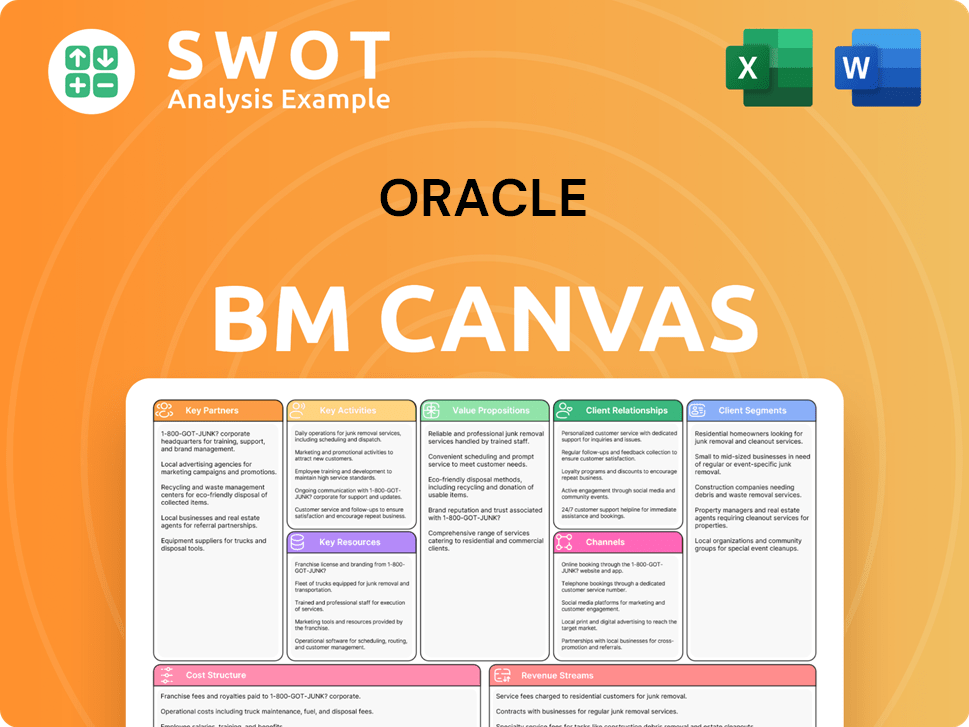
What is the Timeline of Key Events for Oracle?
The history of Oracle Corporation, from its founding as Software Development Laboratories (SDL) in 1977 to its current status as a major player in cloud computing and AI, is marked by significant milestones. Initially focused on database technology, the company, spearheaded by Larry Ellison, quickly evolved, releasing its first commercial SQL relational database, Oracle 2, in 1979. Over the years, Oracle expanded its offerings, made strategic acquisitions, and adapted to the changing technological landscape, including a strong pivot towards cloud services, as detailed in Revenue Streams & Business Model of Oracle.
| Year | Key Event |
|---|---|
| 1977 | Founded as Software Development Laboratories (SDL) in Santa Clara, California. |
| 1979 | Released Oracle 2, the first commercial SQL relational database; renamed to Relational Software, Inc. (RSI). |
| 1982 | Renamed to Oracle Systems Corporation. |
| 1986 | Initial Public Offering (IPO), raising $31.5 million. |
| 1987 | Became the largest database management company globally. |
| 1992 | Launched Oracle Database 7, introducing significant improvements. |
| 1995 | Company name officially changed to Oracle Corporation. |
| 1998 | Released Oracle 8i, integrating internet capabilities. |
| 2005 | Acquired PeopleSoft for $10.3 billion. |
| 2010 | Acquired Sun Microsystems, gaining Java and Solaris. |
| 2016 | Acquired NetSuite. |
| 2022 | Acquired Cerner, expanding into healthcare IT. |
Oracle is heavily focused on its cloud strategy, aiming to significantly increase revenue. The company's cloud revenue is a key driver of growth. In Q1 FY2025, cloud revenue reached $5.6 billion, and in Q3 FY2025, it grew to $6.2 billion. This growth is supported by a robust remaining performance obligation (RPO) of $99 billion, signaling strong future demand.
Oracle is investing heavily in AI capabilities, including potential construction of nuclear-powered data centers to house Nvidia GPU clusters. The company is making strategic moves to maintain its leadership in the enterprise software and cloud computing sectors. This investment underscores Oracle's commitment to innovation and its vision for the future.
Oracle reported total revenue of $13.3 billion in Q1 FY2025 and $14.1 billion in Q3 FY2025. The company aims to double its total revenue from fiscal year 2024's $53 billion to a projected $104 billion by fiscal year 2029. Cloud services and license support revenues are also increasing, up 12% in Q2 FY2025.
Oracle Cloud Infrastructure (OCI) is a key growth driver, attracting high-profile customers like OpenAI and Meta. The company's ability to secure major clients highlights the competitiveness of its cloud offerings. Oracle's strategic focus on AI and cloud is expected to fuel continued growth.
Oracle Porter's Five Forces Analysis
- Covers All 5 Competitive Forces in Detail
- Structured for Consultants, Students, and Founders
- 100% Editable in Microsoft Word & Excel
- Instant Digital Download – Use Immediately
- Compatible with Mac & PC – Fully Unlocked
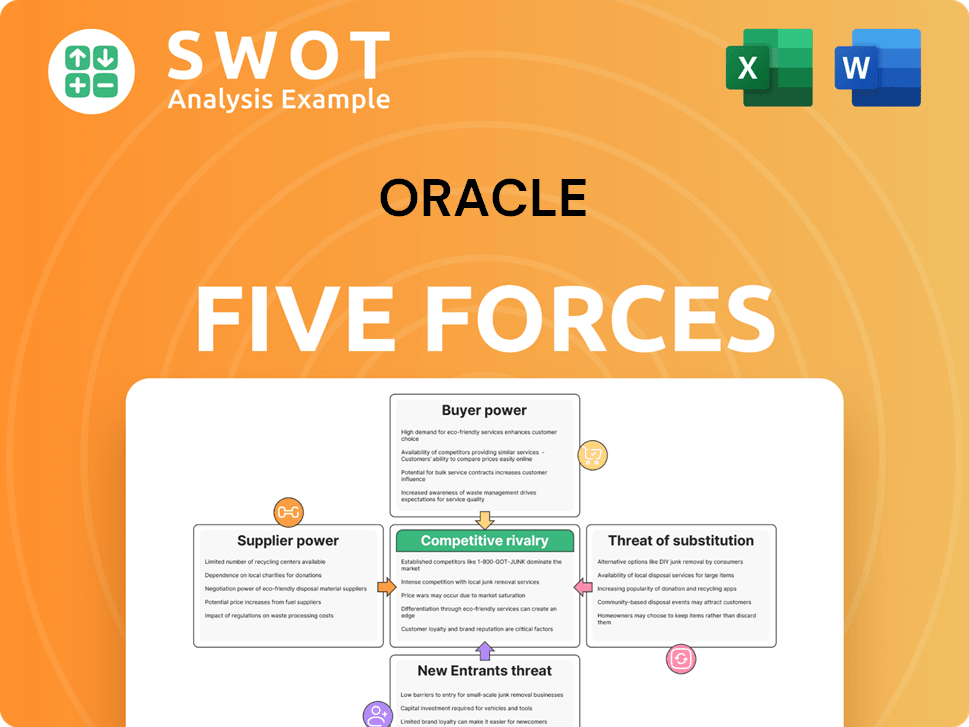
Related Blogs
- What is Competitive Landscape of Oracle Company?
- What is Growth Strategy and Future Prospects of Oracle Company?
- How Does Oracle Company Work?
- What is Sales and Marketing Strategy of Oracle Company?
- What is Brief History of Oracle Company?
- Who Owns Oracle Company?
- What is Customer Demographics and Target Market of Oracle Company?
Disclaimer
All information, articles, and product details provided on this website are for general informational and educational purposes only. We do not claim any ownership over, nor do we intend to infringe upon, any trademarks, copyrights, logos, brand names, or other intellectual property mentioned or depicted on this site. Such intellectual property remains the property of its respective owners, and any references here are made solely for identification or informational purposes, without implying any affiliation, endorsement, or partnership.
We make no representations or warranties, express or implied, regarding the accuracy, completeness, or suitability of any content or products presented. Nothing on this website should be construed as legal, tax, investment, financial, medical, or other professional advice. In addition, no part of this site—including articles or product references—constitutes a solicitation, recommendation, endorsement, advertisement, or offer to buy or sell any securities, franchises, or other financial instruments, particularly in jurisdictions where such activity would be unlawful.
All content is of a general nature and may not address the specific circumstances of any individual or entity. It is not a substitute for professional advice or services. Any actions you take based on the information provided here are strictly at your own risk. You accept full responsibility for any decisions or outcomes arising from your use of this website and agree to release us from any liability in connection with your use of, or reliance upon, the content or products found herein.